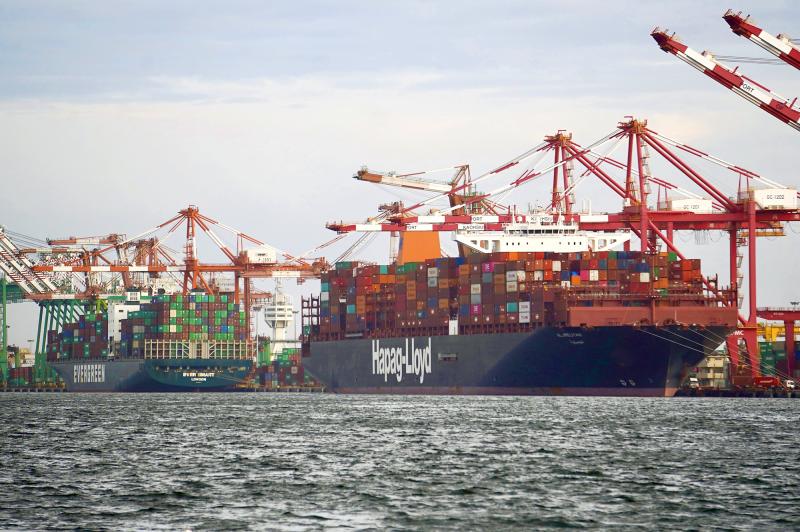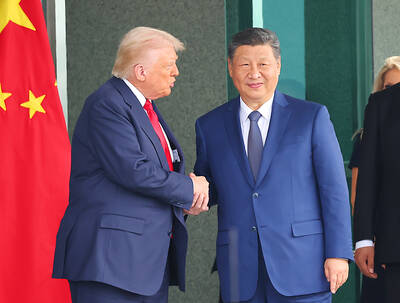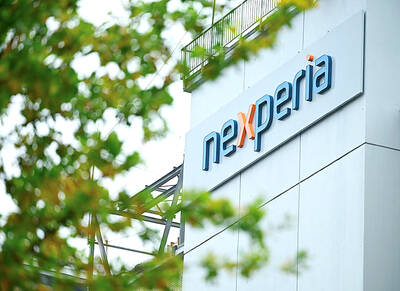Throughput at the nation’s major ports rose more than 6 percent to a new high last year, as exports soared on the back of solid global demand, the Directorate-General of Budget, Accounting and Statistics (DGBAS) said on Thursday last week.
Cargo handled at major international ports — such as Port of Kaohsiung, Port of Keelung, Port of Taichung and Port of Taipei — totaled about 750 million shipping tonnes last year, up 6.7 percent from a year earlier, agency data showed. Shipping tonnage is the measurement used to bill cargo handled by ports.
As the nation’s export performance improved last year, port throughput reversed a year-on-year 3.8 percent decline in 2020 and a 1.4 percent drop in 2019, the DGBAS said.

Photo: CNA
Riding a wave of strong demand for emerging technology products as well as raw materials as part of a global economic recovery amid the COVID-19 pandemic, Taiwan’s exports climbed to a record high, with annual growth of almost 30 percent.
The agency said that cargo loading volume reached about 308 million shipping tonnes last year, up 5.3 percent from a year earlier and accounting for 41.1 percent of total port throughput, while cargo unloading volume was about 442 million shipping tonnes, up 7.7 percent from a year earlier, making up 58.9 percent of the total.
The Port of Kaohsiung handled the largest volume of cargo last year with about 440 million shipping tonnes, which accounted for 58.6 percent of the nation’s total throughput, followed by the Port of Taichung (139 million shipping tonnes, or 18.6 percent), the Port of Taipei (89.67 million shipping tonnes, or 12 percent) and the Port of Keelung (65.46 million shipping tonnes, or 8.7 percent), the DGBAS said.
Last year, Taiwan’s major ports handled 552 million shipping tonnes of container cargo, up 6 percent from a year earlier and accounting for 73.6 percent of the total, the agency said.
Pipeline cargo, including crude oil and other liquefied items, reached 56.95 million shipping tonnes last year to make up 7.6 percent of total throughput, followed by coal (5.4 percent), iron sand (3.7 percent) and iron ore (3.1 percent).

RUN IT BACK: A succesful first project working with hyperscalers to design chips encouraged MediaTek to start a second project, aiming to hit stride in 2028 MediaTek Inc (聯發科), the world’s biggest smartphone chip supplier, yesterday said it is engaging a second hyperscaler to help design artificial intelligence (AI) accelerators used in data centers following a similar project expected to generate revenue streams soon. The first AI accelerator project is to bring in US$1 billion revenue next year and several billion US dollars more in 2027, MediaTek chief executive officer Rick Tsai (蔡力行) told a virtual investor conference yesterday. The second AI accelerator project is expected to contribute to revenue beginning in 2028, Tsai said. MediaTek yesterday raised its revenue forecast for the global AI accelerator used

TEMPORARY TRUCE: China has made concessions to ease rare earth trade controls, among others, while Washington holds fire on a 100% tariff on all Chinese goods China is effectively suspending implementation of additional export controls on rare earth metals and terminating investigations targeting US companies in the semiconductor supply chain, the White House announced. The White House on Saturday issued a fact sheet outlining some details of the trade pact agreed to earlier in the week by US President Donald Trump and Chinese President Xi Jinping (習近平) that aimed to ease tensions between the world’s two largest economies. Under the deal, China is to issue general licenses valid for exports of rare earths, gallium, germanium, antimony and graphite “for the benefit of US end users and their suppliers

Dutch chipmaker Nexperia BV’s China unit yesterday said that it had established sufficient inventories of finished goods and works-in-progress, and that its supply chain remained secure and stable after its parent halted wafer supplies. The Dutch company suspended supplies of wafers to its Chinese assembly plant a week ago, calling it “a direct consequence of the local management’s recent failure to comply with the agreed contractual payment terms,” Reuters reported on Friday last week. Its China unit called Nexperia’s suspension “unilateral” and “extremely irresponsible,” adding that the Dutch parent’s claim about contractual payment was “misleading and highly deceptive,” according to a statement

Artificial intelligence (AI) giant Nvidia Corp’s most advanced chips would be reserved for US companies and kept out of China and other countries, US President Donald Trump said. During an interview that aired on Sunday on CBS’ 60 Minutes program and in comments to reporters aboard Air Force One, Trump said only US customers should have access to the top-end Blackwell chips offered by Nvidia, the world’s most valuable company by market capitalization. “The most advanced, we will not let anybody have them other than the United States,” he told CBS, echoing remarks made earlier to reporters as he returned to Washington